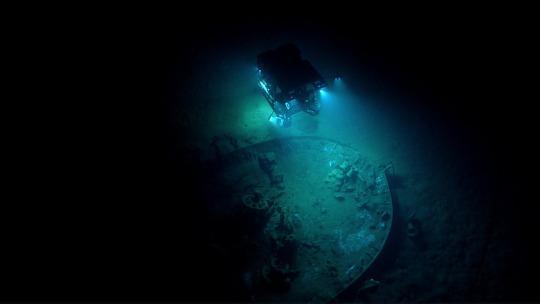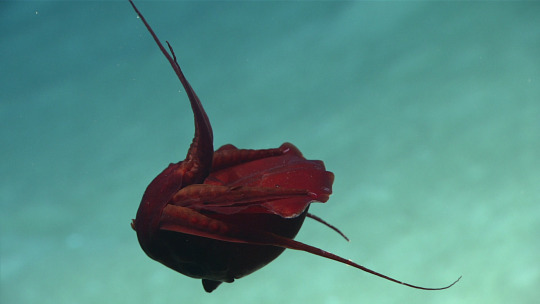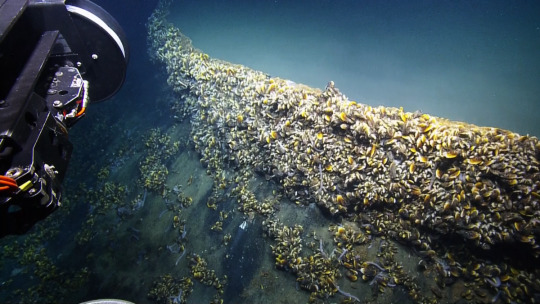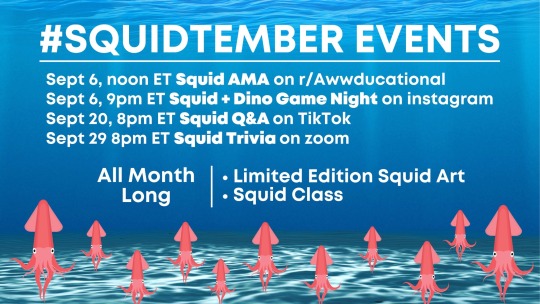#oceanx
Text





28 notes
·
View notes
Text
Every single sea tourist who looked at the Titan specs and says, “No, that looks bad” didn’t make the news. There may have been many of them. If so, I’m not sure what we do with this information.
7 notes
·
View notes
Text

https://x.com/oceanx/status/1709311362885644538?s=46&t=HJT0AiBW4bv8qxTovZYFBA
Today I learned that whales play with kelp.
#splatoon#my art#echoling#echolings#kelp#kelp hat#kelp ball#baby echolings#quick sketch#sketches#sketch#Splatoon echolings#oceanx#whale facts#whale facts illustrated
4 notes
·
View notes
Note
hi! i recently graduated with a degree in marine biology. i'm undecided on whether or not i want to go to grad school, but cephalopods are my passion in life, and i would love to stay involved with the science while i'm out of school. do you know any good ways to do so? thanks so much, i love your work (i wear my squid facts shirt regularly!)
I think there are a LOT of ways to do this, and the answer really depends on what you're already doing, who you're currently connected with, and where you're living.
Follow dives from Schmidt Ocean, OceanX and OceanExplorer
Look for online lectures you can attend to keep up with the latest in your field without shelling out $$ for a masters or something
Keep learning. There's no amount of formal education that will teach you everything there is to know on a topic. Read more books, read more papers, talk to other scientists online
IF you have connections to a lab, keep working with them when you can. This is not going to work for everyone. This is impractical advice. But for some people it works.
Good luck!!
26 notes
·
View notes
Text





earth fact time. in the deep ocean there are things called brine pools, which are essentially lakes of water separate from the ocean water. they're formed when water seeping through the ocean floor mixes with salt deposits, so the actual brine pools themselves are too salty and too toxic for most things to live in. but because they're so mineral rich, there's a bunch of really cool things living around them!
some examples include mussels, crabs, echinoderms, and sea cucumbers.
oceanx | oceanexplorer (noaa) | la times
photos: nautilus live x | x
#im very normal about brine pools i swear (i need to live in there)#aquatic#earthposting#facts!#geology#geography#brine pools#oceanography#gastropods#mussels#crustaceans#crabs#echinoderms#holothurians#sea cucumbers#benthic zone#sea floor#ocean floor#oceans#earth fact no. 26
8 notes
·
View notes
Text
i could go into ocean exploration… call it OceanX….
6 notes
·
View notes
Text
Charting the Course of Innovation: Mingyang Group's OceanX Twin-Rotor Floating Platform Sets Sail for a Sustainable Future
In the vast expanse of the ocean, where the winds whisper tales of untapped energy potential, Mingyang Group stands at the helm of innovation, steering the course towards a sustainable future. With the unveiling of the OceanX twin-rotor floating platform, Mingyang Group pioneers a new chapter in the saga of renewable energy, promising to reshape the offshore wind landscape with unprecedented efficiency and ingenuity.
The genesis of OceanX traces back to the convergence of visionary ambition and unwavering commitment to technological advancement. Mingyang Group, renowned for its trailblazing endeavors in wind energy, embarked on a journey fueled by the relentless pursuit of excellence. After rigorous research and development, OceanX emerges as the epitome of maritime engineering brilliance, poised to redefine the boundaries of offshore wind energy generation.
At the heart of OceanX lies a symphony of innovation, meticulously orchestrated to harness the elemental power of the ocean's breath. The platform's twin-rotor configuration, a marvel of engineering prowess, embodies the essence of synergy, enabling two turbine rotors to harmonize their efforts in the pursuit of sustainable energy production. Mingyang Group's MySE8.3-180 semi-direct-drive offshore wind turbines, elegantly poised atop the V-shaped tower, herald a new era of renewable energy efficiency.
Delving deeper into the intricacies of OceanX's design reveals a tapestry woven with precision and foresight. The V-shaped tower, adorned with elliptical cross-sections, serves as a testament to Mingyang Group's commitment to performance and resilience. Engineered to withstand the relentless onslaught of nature's fury, OceanX stands as a bastion of stability, even amidst the tempestuous chaos of typhoon conditions.
Assembling OceanX at the Huangchuan Wharf in Guangzhou, Guangdong Province, marks the genesis of a transformative journey. Each rivet, each bolt, bears witness to the collective ingenuity and tireless dedication of Mingyang Group's engineering prowess. Amidst the bustling activity of assembly, OceanX emerges as a beacon of hope, illuminating the path towards a greener, more sustainable future.
Yet, amidst the fervor of anticipation, questions linger, casting shadows of doubt upon the horizon. Can twin-tower platforms truly deliver on their promise of enhanced efficiency and power generation? What challenges lie ahead on the path to widespread adoption and scalability? Mingyang Group's OceanX serves as a catalyst for introspection, prompting stakeholders to engage in a dialogue that transcends boundaries and embraces the spirit of collaboration.
The journey of OceanX extends far beyond the shores of Guangzhou, transcending geographical boundaries to inspire a global community united in its pursuit of a common goal. As the platform embarks on its maiden voyage off the coast of Qingzhou, Yangjiang, the world watches with bated breath, eager to witness the dawn of a new era in renewable energy.
If you want to learn more about wind energy, check out the "Wind Energy Fundamentals: Renewable Energy Power Course".
Discover the secrets of wind turbines and wind farm management in this comprehensive video course. Whether you're an aspiring energy engineer or seeking a career in the industry, our course provides the essential knowledge you need. From basics to project design, embark on your fulfilling journey towards a phenomenal career today!"
In the crucible of innovation, where ideas collide and dreams take flight, Mingyang Group invites you to join the conversation. How do you envision the future of offshore wind technology? What role do you see OceanX playing in the transition towards a sustainable energy ecosystem? Share your insights, your aspirations, and your dreams as we navigate the uncharted waters of tomorrow.
0 notes
Text
Human technology has long drawn inspiration from the natural world: The first airplanes were modeled after birds. The designer of Velcro was inspired by the irksome burrs he often had to pick off his dog. And in recent years, engineers eager to explore the world’s oceans have been taking cues from the creatures that do it best: fish.
Around the world, researchers developing robots that look and swim like fish say their aquatic automatons are cheaper, easier to use, and less disruptive to sea life than the remotely operated vehicles (ROVs) scientists use today. In a recent review of the technology’s advances, scientists claim only a few technical problems stand in the way of a robotic fish revolution.
Over the past few decades, engineers have designed prototype robotic fish for a variety of purposes. While some are built to carry out specific tasks—such as tricking other fish in a lab, simulating fish hydrodynamics, or gathering plastics from the ocean—the majority are designed to traverse the seas while collecting data. These robotic explorers are typically equipped with video cameras to document any life forms they encounter and sensors to measure depth, temperature, and acidity. Some of these machines—including a robotic catfish named Charlie, developed by the CIA—can even take and store water samples.
While modern ROVs can already do all these tasks and more, the review’s authors argue that robotic fish will be the tools of the future.
“The jobs done by existing [ROVs] can be done by robotic fish,” says Weicheng Cui, a marine engineer at Westlake University in China and a coauthor of the review. And “what cannot be done by existing ROVs may [also] be done by robotic fish.”
Since the invention of the first tethered ROV in 1953—a contraption named Poodle—scientists have increasingly relied on ROVs to help them reach parts of the ocean that are too deep or dangerous for scuba divers. ROVs can go to depths that divers can’t reach, spend a virtually unlimited amount of time there, and bring back specimens, both living and not, from their trips.
While ROVs have been a boon for science, most models are large and expensive. The ROVs used by scientific organizations, such as the Monterey Bay Aquarium Research Institute (MBARI), the Woods Hole Oceanographic Institution, the Schmidt Ocean Institute, and OceanX, can weigh nearly as much as a rhinoceros and cost millions of dollars. Such large, high-end ROVs also require a crane to deploy and must be tethered to a mother ship while in the water.
In contrast, robotic fish are battery-powered bots that typically weigh only a few kilograms and cost a couple thousand dollars. Although some have been designed to resemble real fish, robotic fish typically come in neutral colors and resemble their biological counterparts in shape only. Yet, according to Tsam Lung You, an engineer at the University of Bristol in England who was not involved in the review, even the most unrealistic robot fish are less disruptive to aquatic life than the average ROV.
Unlike most ROVs that use propellers to get around, robotic fish swim like the animals that inspired them. Flexing their tails back and forth, robotic fish glide through the water quietly and don’t seem to disturb the surrounding marine life—an advantage for researchers looking to study underwater organisms in their natural environments.
Because robotic fish are small and stealthy, scientists may be able to use them to observe sensitive species or venture into the nooks and crannies of coral reefs, lava tubes, and undersea caves. Although robotic fish are highly maneuverable, current models have one big downside: their range is very limited. With no mother ship to supply them with power and limited room to hold batteries, today’s robotic fish can only spend a few hours in the water at a time.
For robotic fish to make modern ROVs obsolete, they’ll need a key piece that’s currently missing: a docking station where they can autonomously recharge their batteries. Cui envisions a future where schools of small robotic fish work together to accomplish big tasks and take turns docking at underwater charging stations powered by a renewable energy source, like wave power.
“Instead of one [ROV], we can use many robotic fish,” Cui says. “This will greatly increase the efficiency of deep-sea operations.”
This potential future relies on the development of autonomous underwater charging stations, but Cui and his colleagues believe these can be built using existing technologies. The potential docking station’s core, he says, would likely be a wireless charging system. Cui says this fishy future could come to fruition in under a decade if the demand is great enough.
Still, getting scientists to trade in their ROVs for schools of robotic fish may be a tough sell, says Paul Clarkson, the director of husbandry operations at the Monterey Bay Aquarium in California.
“For decades, we’ve benefited from using the remotely operated vehicles designed and operated by our research and technology partner, MBARI,” says Clarkson. “Their ROVs are an essential part of our work and research, and the capabilities they provide make them an irreplaceable tool.”
That said, he adds, “with the threats of climate change, habitat destruction, overfishing, and plastic pollution, we need to consider what advantages new innovations may offer in understanding our changing world.”
0 notes
Text
0 notes
Text
Few marine scientists are Black. A Spelman College-OceanX effort aims to change that.
Read the full story at The 19th.
A collaboration between the historically Black women’s college and an exploration nonprofit will allow students to spend weeks at sea with experts of color on the research ship OceanXplorer.
View On WordPress
0 notes
Text
The Baltic Sea Anomaly
Did You Hear About This?
Ancient Monument, Geological Formation, Russian Bunker, or Something Else?
During a treasure hunting trip by a Swedish OceanX diving team in June 2011, they noticed something with unusual features on their sonar. Experts think natural geological formations are behind the image. But is it the case? A 70-meter-long (210-foot) odd-shaped feature appeared on sonar 100 meters (300 feet) below the…
View On WordPress
0 notes
Text
Tidal Wave of New Creative Exploration Submerses Kids at Crayola Experience with Limited-time OceanX Takeover
EASTON, Pa. (April 6, 2023) – Crayola Experience Easton and OceanX are bringing families the latest deep-sea adventure of colorful, FIN-tastic fun with a limited-time, immersive attraction takeover.
The most colorful family destination in Pennsylvania and the global non-profit ocean exploration organization have partnered again to bring the wonders of the ocean to the next generation through…

View On WordPress
0 notes
Photo

🤍Si sabes porque te enamoras, no estás enamorado🪞 (en OceanX) https://www.instagram.com/p/CkzrqiPuFW0/?igshid=NGJjMDIxMWI=
0 notes
Text
Ways to prepare yourself for #Squidtember
1) Mark your calendars with the squid events listed below!!
2) Think of all the squid questions. I will be SO READY to answer them.
3) Look around your space. Where needs squid art? Probably lots of places because the world needs more squid art!!! (And we’re releasing a collection to support the squid facts hotline on Thursday in collaboration with @seanmartorana)
4) Follow OceanX on all the platforms because there’s going to be A LOT of squid happening over there
5) Ponder your favorite squid. This should be a frequent activity but it has extra special meaning leading up to #Squidtember.

Here’s the link for the squid + Dino night
And here’s the link for squid trivia
And here's the link for squid class!
Art at the top is by Sean Martorana, stay tuned for more amazing squid art by Sean!
#squid#cephalopods#science#marine biology#cephalopod#sealife#marine life#marine science#squid squad#oceans#squidtember
150 notes
·
View notes
Text
Ski doo rail ice scratchers damaged rails

#Ski doo rail ice scratchers damaged rails full#
This 2006 Carver 41 Cockpit Motor Yacht also offers the best attributes of a Sedan Bridge: Level Enrty into the Vessel through the Sliding Glass Door off of the Aft Cabin, with an Upper Cockpit at the Helm, A Mid-Level Cockpit at the Manway, and a Lower Cockpit at Waters Level, adjacent to the generous Swim Platform!! The Layout and Flow of the boat really allows the boat to function nicely as a Liveaboard. Opposite of the Main Salon is the Second Cabin which also has a Roomy Enclosed Head with Jack N-Jill Doors to allow access to the Enclosed Head from either the Main Salon or the Forward Cabin.
#Ski doo rail ice scratchers damaged rails full#
The boat offers the best attributes of a Motor Yacht: A Full Beam Aft Cabin with Private Enclosed head off of the Aft Cabin, separated by a Large, Open, and Roomy Main Salon. She is powered by twin Volvo Penta (395 hours) Diesel D-6s (370 Horsepower each) paired up to Volvo Inboards. This Top-Quality, Luxury Cockpit Motor Yacht is in Great Condition. Dont Miss This Great Opportunity, Offers Encouraged! Inquire Today!! Exceptionally Nice 268 Albemarle, This Beauty Is Powered With A 1,117 Hour 8.1L Volvo And Coupled To A Volvo OceanX Outdrive, Nice Electronics Package Include Twin Raymarine E80S W/ Raymarine Radome Radar Antennae, Raymarine Dragonfly-7, Kenwood AM FM CD Player W/ Pilot Remote Control, Overhead Console W/ VHF Radio, Hardtop W/ Front And Side Curtains, Rocket Launchers And Spreader Lights, Taco Marine Grand Slam Top Mount W/ Outriggers, Nice Open Cockpit Features A Self Bailing Deck, Fresh And Raw Water Wash-Downs, Transom Fish Locker, Live Well Rear Of Extra Wide Companion Seat, Generous Cabin, Galley W/ Microwave Oven, Solid Surface Counter Top, Sink, Private Head Jabsco Electric Marine Head, Sink And Faucet/Shower Head, Spacious V-Berth, Additional Features Include Swim Platform W/ Boarding Ladder, Windlass, Lumitec SeaBlaze Mini LED Underwater Lighting, New Trailer Available.

0 notes
Text
Hedge fund titan, Ray Dalio, on taking the plunge into ocean exploration
Hedge fund titan, Ray Dalio, on taking the plunge into ocean exploration
CNN’s Richard Quest spoke to the founder of the world’s biggest hedge-fund firm, who is investing in what he calls the planet’s most important asset: the ocean. Ray Dalio and his son founded OceanX, an initiative to study and capture footage of the deep. Designed with help from film director James Cameron, the OceanXplorer ship is a floating laboratory kitted out with Hollywood-standard studio…

View On WordPress
0 notes